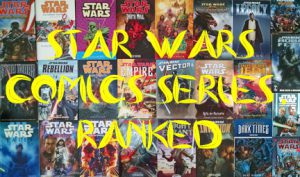I didn’t remember a lot of details from the “X-Wing” series from my first readings back in the 1990s, but I did distinctly recall Ton Phanan’s death scene in the sixth book, “Iron Fist” (1998). This was the book — and that chapter in particular — that propelled Aaron Allston to the top of the list of my favorite “Star Wars” authors (Karen Traviss would later surpass him).
It’s remarkable how strong that memory is, because there aren’t actually a lot of pages devoted to the friendship between Ton and Face Loran. In fact, Face notes that he had only known Ton for a few weeks. Their close friendship — even relative to the increasingly tight bond among Wraith Squadron members — nicely illustrates the heightened emotions that can come from wartime.
“Iron Fist” is a document of Allston becoming a great writer. Sure, it’s sometimes a bit herky-jerky like his first entry, the more-padded “Wraith Squadron” (this one is about 100 pages shorter). But that’s because he gives substantial page time to all 13 members of Wraith Squadron; and rather than this being confusing, almost every character arc is distinctly compelling.
The 13th member is Lara Notsil, formerly Gara Petothel. Allston gets into her head as she gradually transforms from a Warlord Zsinj loyalist to someone who appreciates the New Republic’s cause simply by observing her new squad mates.
Speaking of Zsinj, he comes into his own as a legitimate villain here, as he attempts to add a second Super Star Destroyer to a fleet that already includes the titular vehicle. We also get a tidbit for future yarns: It seems the very lab that produced super-smart Gamorrean pilot Piggy is operating in the bowels of the Iron Fist, and it’s even experimenting on Ewoks, perhaps making the Wraith’s running joke about an Ewok pilot no joke after all.
Zsinj’s personal rivalry with Han Solo isn’t as well developed here as it could be, partly because we see everything through the Wraiths’ eyes (the next book, “Solo Command,” might rectify that a bit). And I find Han to be slightly out of his element as the leader of a capital ship; however, that’s sort of the point, and it’s important that we see him actually backing up the promotion that happened off-screen during the time of the films (come to think of it, we don’t see a lot of Luke or Lando earning their commissions either).
“Iron Fist” also includes a nice continuation from Michael Stackpole’s “X-Wing” comics, which take place before the “X-Wing” books but were written simultaneously. Baron Soontir Fel, who considers himself to be the best pilot in the galaxy (and often backs up the boast), reappears here in the employ of Zsinj. Wedge wonders why Fel abandoned the New Republic. And also, what is the fate of Wedge’s sister — Fel’s wife — Syal Antilles?
Certainly, that’s a juicy thread that could finally make these “X-Wing” books a little more personal for Wedge, always the straight-laced (at least by Wraith standards) leader. Because for all the great character arcs here, oddly it’s Wedge who gets comparatively short shrift.

Stray observation: On page 252, Wedge says, “For those of you who believe in the Force, may it be with you, and guide you. For those who don’t, trust in your intent, your weapons, and your wingman.” Allston somewhat daringly directly correlates the Force to Western religions’ God here, but I’d argue it’s not the same. Luke or any Jedi could easily demonstrate the use of the Force in a controlled experiment that would hold up to scientific scrutiny.
However, at this point in the “Star Wars” timeline, we are three decades removed from the height of Jedi power and another decade away from the return of that power to prominence — exactly in the sweet spot where the idea of the Force could indeed devolve to status as a mere religion. No doubt Wedge knows the Force is real, as he’s a good friend of Luke’s; however, in this speech he seems to respect that many of his fellow pilots have not had the experience of knowing a Jedi.

